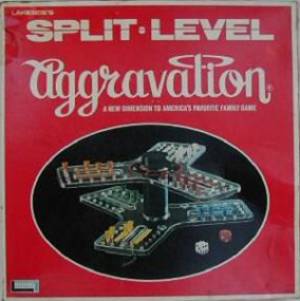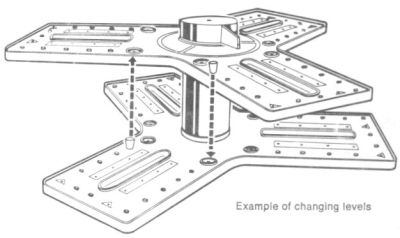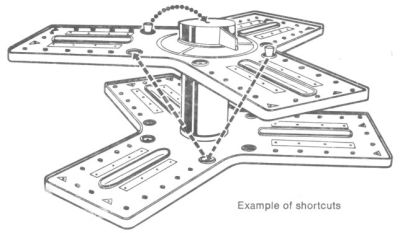
Split Level Aggravation
1971 Lakeside IndustriesGENERAL RULES:
Split-Level Aggravation is a 3 dimensional game whose design changes continually throughout its play. This "living" aspect of the game challenges players to be visually astute and forever on guard.OBJECT:
The object of Split-Level Aggravation is for a player to move all 4 of his playing pieces around the game board from his "base" position to "home." In order to reach "home" (if no shortcuts or changing of level are used), a playing piece must travel around the outer edge of the playing surface on which its "base" is located (see "Shortcuts").1. PREPARATION:
The playing surface is assembled as shown on the illustration. Each player takes 4 playing pieces of the same color and places them on the base row of the corresponding color. Players now roll the white die to determine first player (highest roll going first) and the game is ready to begin.
STARTING PLAY AND DICE:
To get any playing piece out of its base row and into its starting position (putting it into play), a 1 or a 6 must be rolled with the white die. Until a player gets his first piece into play he uses only the white die; thereafter, he uses both the red and the white dice.The red die determines the rotation of the top level of the playing surface. The level is turned so that the indicator points to the number rolled.
The white die determines the number of moves a playing piece may take. A player can move any of his playing pieces, that are in play, the number rolled. Play is always clockwise.
A white 6 enables the player to move his piece, then take another turn.
EQUIPMENT:
The equipment consists of a 3 dimensional playing surface whose top level rotates, 24 playing pieces (6 sets of 4 pieces each), 1 red die and 1 white die.2. MOVING FROM LEVEL TO LEVEL:
When a playing piece lands on a black circle and has more moves to make, it is placed on the black circle directly above or below it and continues. The placement from one level to another does not count as one of the number rolled.
AGGRAVATION
A player can land on or move over an opponent's piece. When a player lands exactly on an opponent's piece (on the last number he rolled), the opponent's piece is "aggravated," that is, removed and placed back in his base position. A player may not land on or move over his own piece3. SHORTCUTS:
There are 2 optional shortcuts in Split-Level Aggravation.A. When a player lands exactly on a black circle (with the last number he rolled), he may, on his next turn, move from black circle to black circle by-passing the rest of the board. This is done clockwise and between black circles on alternative levels. For example, if you were on the top level you could move to the left, diagonally downward, to the next black circle, then diagonally upwards to the next black circle, moving up and down as you move around the board. If you reach the circle you desire and have numbers left, you continue from there in a normal fashion.
B. When a player rolls a number that leaves him 1 move beyond a black circle (for example, a player rolls a 5 and the fourth move places him on a black circle), he may jump to the center hole on the indicator. In order to leave the center hole position a player must roll a 1. At this time he may proceed to any of the black circles on either level. If a player desires to take this shortcut with a playing piece that is already in the black circle, the only way he can jump into the center position is to roll a 1 on the white die.

Shortcuts offer a fine defensive maneuver when one of the opponents is nearly finished, as well as shortening the distance to a player's home. However, shortcuts are popular and you can be "aggravated" from them too!
MOVE INTO "HOME"
A player must roll the exact number on the white die to move his pieces into the 4 home positions. Any piece in its home position is safe from "aggravation."